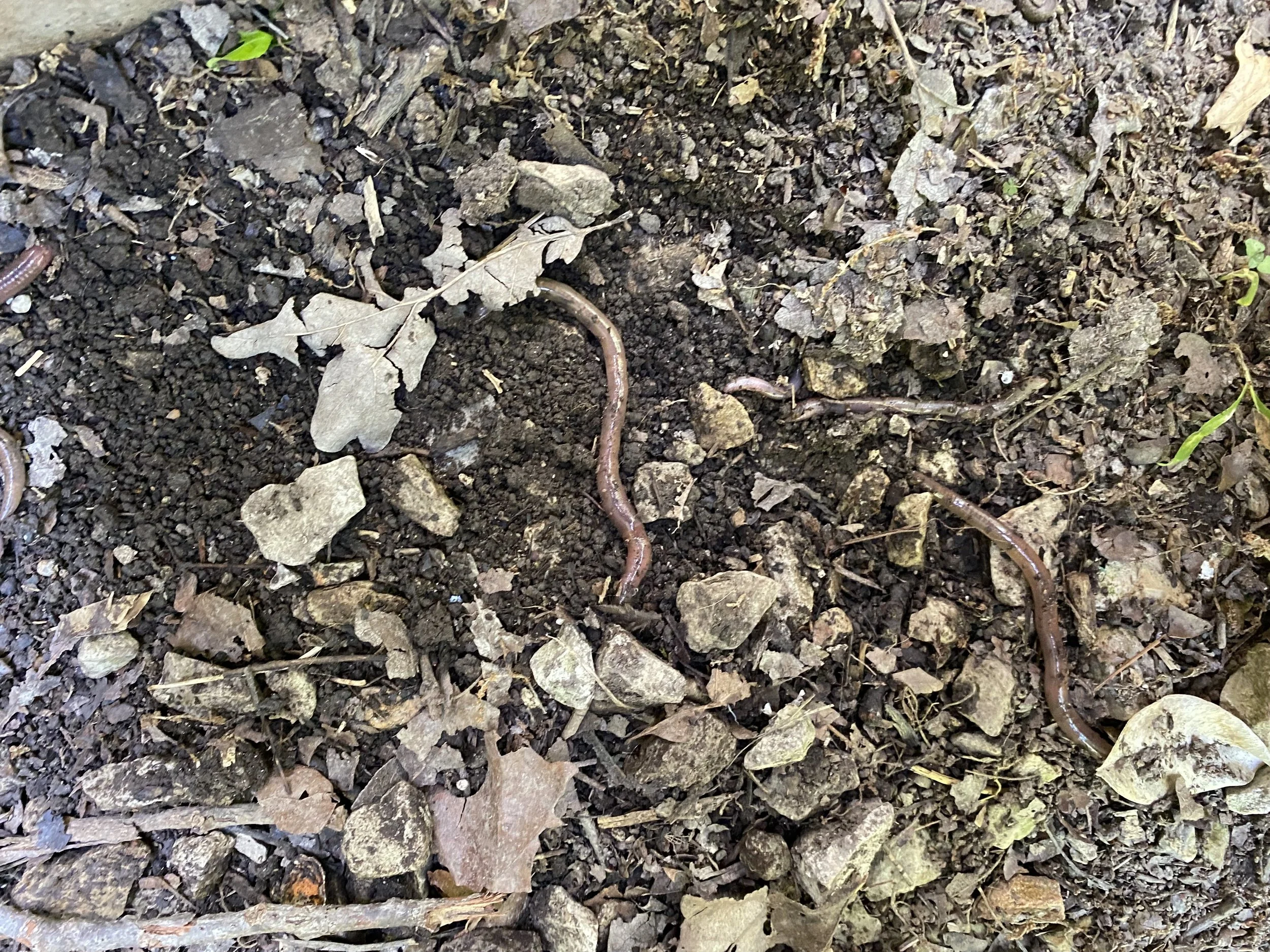Invasive Jumping Worms
/Invasive jumping worms look similar to earthworms but are dry and fast-jumping. (Charlotte Ekker Wiggins photo)
Invasive Jumping Worms
I read about this threat to soil health a couple of years ago. Like most invasives, jumping worms grow faster than earth worms, consume more nutrients and basically can destroy the matrix of soil and soil nutrients.
As I was moving a pot of begonias in the shade outside of my garage door June 13, 2022, I was surprised to find a mount of greyish worm castings under the pot. Knowing what worm poop looks like from my two red wriggler composting farms, I was intrigued. I had never seen “earthworms” at the soil surface in leaf litter nor jumping around as I uncovered them.
On closer inspection of the squiggly grey worms, some dropped their tails. Then I noticed a whitish or beige smooth band that circled all around from about an inch from their tips. Not earthworms; definitely invasive jumping worms confirmed by Missouri Department of Conservation.
Lightly scraping leaf litter over gravel, I found several more jumping worms. (Charlotte Ekker Wiggins photo)
Introduced Species for Anglers
According to the Missouri Department of Conservation, Missouri is among 34 states with invasive jumping worms. The worms are native to East Asia and are a glossy gray or brown with a white band. When exposed, they thrash and leap around like a snake.
Missouri Department of Conservation spokesperson Dan Zarlenga explained that this species of worm was first introduced for anglers. He said reports of jumping worms in the state have mainly come from northern Missouri. Well, until now.
These jumping worms are good for aerating soil, but they consume a lot of organic matter making it harder for the soil to hold water. They also reproduce a lot faster than worms that are native to Missouri.
Zarlenga said they become sexually mature in about 60 days after hatching. Worms can also reproduce on their own.
Telltale smooth neck band about an inch from the tip. (Charlotte Ekker Wiggins photo)
Jumping Worms v. Earthworms
Jumping worms are often mistaken for earthworms. If you’ve spent any time digging up earthworms for fishing, you know earthworms don’t jump around as fast as jumping worms. The band about an inch from their tip has ridges and doesn’t encircle them. Earthworms also live deeper in the soil, some 5 inches or so.
Jumping worms are drier than common native earthworms. They could also have an iridescent sheen to them, and darker on the top and lighter on the bottom.
Missouri’s earthworms and jumping worms both have a clitellum which is like a collar behind their head. The earthworms’ clitellum is thick and stands out, encircling part of the body while jumping worms’ clitellum is smooth, the same size as the body and encircles the whole the body.
Jumping worms’ also drop their tails when caught.
Damage to Ecosystem
Mo. Department of Conservation notes “Invasive jumping worms consume more soil nutrients than other earthworms, meaning that they actually deplete the soil of nutrients, rendering the soil less fertile for plants; and without plants, the soil is more likely to erode. Where a large population of these worms is established, the soil surface looks dry and granular, like coffee grounds or cooked up ground beef. Leaf litter disappears.
Invasive jumping worms damage forest ecosystems by rapidly eating up the leaf litter that usually protects forest topsoils. Without that mulchlike layer, the bare soil dries rapidly and is subject to erosion. Young forest plants have a difficult time getting established. The soil chemistry changes, and the soil’s microbial communities (bacterial, fungi, and other microbes) change as well. The amount of mycorrhizal fungi (which attach to plant roots in a symbiotic relationship) declines, making it harder for trees to take in nutrients.
Without the protective layer of leaf litter, many invertebrates (other worms, millipedes, centipedes, springtails, arachnids, and countless types of insects), plus amphibians, reptiles, small mammals, and ground-nesting birds, lose important habitat. Thus species diversity declines and forest food chains are disrupted.”
Removing Jumping Worms
Once I confirmed these were jumping worms, I dug up all I could find in the leaf litter over the gravel by my garage door. They were placed in a plastic bag and left in the sun to die. They were then added to my compost.
I’ve spent decades building up and keeping what little soil I have on this hillside healthy and enriched. I don’t need jumping worms destroying all of those years of caring for soil.
For more gardening, beekeeping, cooking and easy home decor tips, subscribe to Garden Notes.













